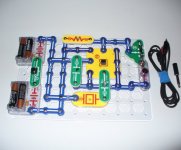Yup we have a saying here, "as cheap as chips" 😀
I recon many of them don't swing enough current so you get loads of detail but poor dynamic impact = less involvement in the music.
I recon many of them don't swing enough current so you get loads of detail but poor dynamic impact = less involvement in the music.
Bill,
Always the fb loop. Insufficient drive capability => large values in the fb loop => thermal noise. As far as I comprehend the criticism voiced at some stage by John. And I can envisage circumstances where this plays a role, although audio might not be one of them.
Always the fb loop. Insufficient drive capability => large values in the fb loop => thermal noise. As far as I comprehend the criticism voiced at some stage by John. And I can envisage circumstances where this plays a role, although audio might not be one of them.
Current swing? What are you driving with your opamp?
Grados, they seem to like plenty of current. Think i'll build an O2 as a winter project. Time to get stomping 😉
in addition, op-amps are bad for marketing high end stuff.
This is probably their main drawback.
https://www.youtube.com/watch?v=MDo9BY72AU4

Bill,
Always the fb loop. Insufficient drive capability => large values in the fb loop => thermal noise. As far as I comprehend the criticism voiced at some stage by John. And I can envisage circumstances where this plays a role, although audio might not be one of them.
Until it's a FET-input opamp, where that's mitigated heavily (at least below ~10k). 🙂 But, absolutely, especially if we're talking your low nV BJT-input opamps.
The best part of opamps is that the good ones all sound the same when properly implemented. 🙄
The best part of opamps is that the good ones all sound the same when properly implemented. 🙄
AD797 is different 😉
I can't tell you much, because it is shall we say "confidential" but this I can say - there is a way to perfect the use of a ua709... say no more!
in addition, op-amps are bad for marketing high end stuff.
I see some 8 legs in here. http://www.sutherlandengineering.co...014/10/Sutherland-PhonoBlock-OwnersManual.pdf
The best part of opamps is that the good ones all sound the same when properly implemented. 🙄
No, this CAN'T be true! If something costs more, it just HAS to sound better!Bear finally said something that makes sense! We should all celebrate.
I see some 8 legs in here. http://www.sutherlandengineering.co...014/10/Sutherland-PhonoBlock-OwnersManual.pdf
They compensate with brilliant copy:
However, the PhonoBlocks distinguish themselves by including white noise generators --- one for each channel. White noise becomes the input signal and passes thru all stages of the PhonoBlock. You can even use the output of the PhonoBlock as a burn-in signal source for interconnect cables and the rest of your system.
Edit: went back to see if I missed something important. I did. Ground planes are bad, I found out:
The PhonoBlocks addresses the issue of circuit board dielectric in a novel – yet elegantly simple way. All signal carrying conductors are on the top plane of the circuit board. There are no copper conductors on the bottom plane, opposite signal carrying regions. Thus there are no electric fields generated between top and bottom layers. The circuit board dielectric is not exposed to electric fields and there is no undesired storage in circuit board material. The circuit board dielectric is not improved ---------- it is removed. It is as if a window were behind you, instead of in front of you. It is still there, but not in the way of clarity.
Last edited:
I don't believe you.I can't tell you much, because it is shall we say "confidential" but this I can say - there is a way to perfect the use of a ua709... say no more!
The PhonoBlocks addresses the issue of circuit board dielectric in a novel – yet elegantly simple way.
Yay.
Attachments
- Status
- Not open for further replies.
- Home
- General Interest
- Everything Else
- What is wrong with op-amps?
